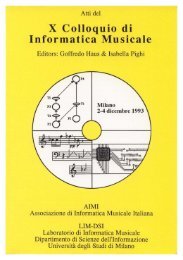Proceedings IX CIM 1991, Genova, November 13-16 - AIMI
Proceedings IX CIM 1991, Genova, November 13-16 - AIMI
Proceedings IX CIM 1991, Genova, November 13-16 - AIMI
You also want an ePaper? Increase the reach of your titles
YUMPU automatically turns print PDFs into web optimized ePapers that Google loves.
HARP: UN AMBIENTE AD ALTO LIVELLO<br />
PER L'AUSILIO ALLA COMPOSIZIONE<br />
A.Camurri, C.Canepa, M.Frixione, C.Innocenti, C.Massucco, R.Zaccaria<br />
DIST - Universitddi <strong>Genova</strong><br />
Laboratorio di Informatica Musicale<br />
Via Opera Pia lIlA - <strong>16</strong>145 <strong>Genova</strong><br />
posta elettronica: music@dist.dist.unige.it<br />
Abstract<br />
This paper describes a methodological framework and a prototype high-level system called HARP<br />
(Hybrid Action Representation and Planning) [3, 4]. HARP is designed to store and process music<br />
and sounds, and to carry out plans for manipulating this material according to the composer's goals.<br />
Therefore, it is able to help in the development of new music pieces as well as in manipulating<br />
existent ones, on the basis of given material: to this end, the system provides also formal analysis<br />
capabilities on both music and sounds; for extracting information useful in subsequent synthesis<br />
processes. In other words, HARP is a system for the representation and manipulation of music<br />
knowledge as regards composition: this is a vast field of knowledge which can be suitably managed<br />
by a twofold formalism. The sound itself (samples, codes, algorithms), real-time performance,<br />
particular analysis processes, are managed by procedures, included in an object-oriented concurrent<br />
environment (HARP analogical subsystem). Higher level scores, composition rules, definitions in<br />
general, descriptions of pieces of music, are stored in a declarative symbolic environment (HARP<br />
symbolic subsystem), based on a multiple-inheritance semantic network formalism derived from KL<br />
ONE [2], that we have extended to represent time, a fundamental aspect of music knowledge [5,6]. A<br />
formal link between the two subsystems exists, so that, for example, asking the semantic network to<br />
generate a particular instance of a music object, automatically "fires" the appropriate procedures at the<br />
analogical level.<br />
A software prototype has been implemented using Arity Prolog and Microsoft C on PC-IBM under<br />
the Microsoft Windows SDK environment.<br />
1. Introduzione<br />
Sistemi informatici per l'ausilio alla composizione sono generalmente basati su strumenti e<br />
linguaggi per la manipolazione a basso livello di suoni, partiture ed algoritmi [I]. Recenti proposte<br />
basate su linguaggi orientati agli oggetti [7] e su tecniche di intelligenza artificiale [5, 6] sono<br />
orientate alla definizione di formalismi piu efficaci e ad alto livello.<br />
Nell'articolo viene introdotto un formalismo basato su tecniche di Intelligenza Artificiale,<br />
denominato HARP (Hybrid Action Representation and Planning), per la memorizzazione e la<br />
manipolazione ad alto livello sia di musica (partiture, descrizioni a diversi livelli di astrazione del<br />
materiale musicale) che di suoni. Tale formalismo e inoltre in grado di gestire la pianificazione di<br />
azioni complesse per la manipolazione di suoni e musica in funzione di obiettivi specificati dal<br />
- 193 -



